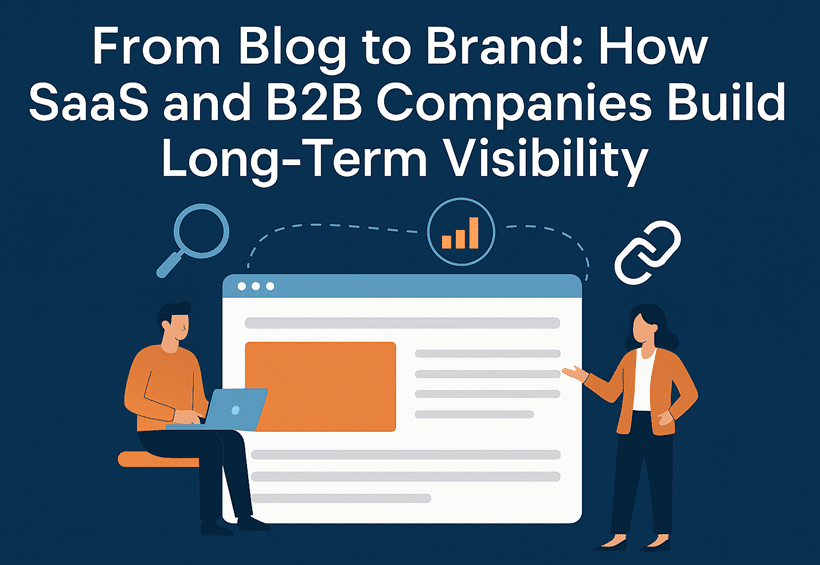
In the digital-first B2B landscape, building long-term visibility is no longer a “nice to have” ; it’s the foundation of brand relevance and sustained pipeline growth. SaaS and B2B companies are realizing that content, specifically blogs, are not just an SEO tool, but are strategic assets that evolve brands from just being discovered to being remembered.
This article breaks down how smart B2B marketers are transforming their blogs into brand powerhouses—layer by layer, tactic by tactic—using content marketing, SEO, and ecommerce development services to drive awareness, trust, and ultimately, revenue.
1. The Shift from Content Quantity to Content Quality
In the early 2010s, it was enough to churn out blog posts targeting keywords. But today, algorithm updates and buyer behavior demand more. Google’s helpful content system now rewards expertise, experience, authoritativeness, and trustworthiness (E-E-A-T), especially for B2B niches where the purchase cycle is complex.
Actionable Tips:
- Conduct a content audit to remove or update thin, outdated, or low-performing content.
- Focus on depth, structure, and intent-matching writing for the buyer, not just for the algorithm.
- Integrate subject matter experts (SMEs) into your content process to strengthen credibility.
Reference: Google’s Search Central Blog on Helpful Content System (2023)
2. Building a Content Strategy That Aligns with the Sales Funnel
To move from blog to brand, SaaS and B2B marketers need content that aligns with the entire buyer’s journey, not just TOFU (top of funnel) SEO plays. That means building out:
- TOFU: Guides, industry trends, how-tos
- MOFU: Comparison pages, case studies, solution-specific content
- BOFU: Product integrations, pricing breakdowns, objection-handling posts
Actionable Tips:
- Map content to buyer personas and sales stages.
- Collaborate with sales and customer success teams to identify content gaps.
- Use heatmaps or CRM analytics to see which content contributes to deal progression.
3. Creating Linkable Assets That Attract Authority and Amplify Reach
High-quality backlinks remain one of the strongest ranking signals for long-term SEO growth. But not all content is created equal when it comes to linkability.
Types of Link-Worthy B2B Content:
- Original research and benchmarks
- Thought leadership and opinion pieces
- Industry roundups and data visualizations
- Tools, calculators, and API documentation (for SaaS)
These assets not only improve SEO but also position your brand as a leader worth referencing.
Actionable Tips:
- Pitch these assets to industry journalists, influencers, or podcast hosts.
- Submit them to syndication networks or industry newsletters.
- Repurpose into infographics for visual platforms like LinkedIn or SlideShare.
Many modern content teams, including niche-focused ones like B2BMonks, emphasize the creation of evergreen linkable assets to build authority within tight verticals.
4. Building Brand Authority Through Thought Leadership
Thought leadership is the bridge between a blog and a brand. In the B2B and SaaS space, buyers want to trust the people behind the product. They want insights, foresight, and experience—not just features.
Actionable Tips:
- Get your founders, product managers, or VPs involved in content.
- Contribute guest articles to industry publications.
- Host webinars, podcasts, or contribute to third-party panels and events.
Example: Drift’s blog became an extension of its leadership by spotlighting thoughts from CEO David Cancel, giving Drift a clear and trusted voice in the B2B martech space.
5. Scaling Through Distribution and Syndication
Publishing content is just the start. The best SaaS and B2B companies engineer distribution into their workflow.
Channels to Consider:
- Email newsletters segmented by buyer persona or stage.
- LinkedIn is still the most powerful B2B distribution platform.
- Syndication: Sites like Medium, Zest, GrowthHackers, and relevant Slack/Discord communities.
- Partnerships: Co-marketing campaigns with complementary tools.
Repurpose blogs into:
- Short-form video (YouTube, LinkedIn, TikTok, if B2B-friendly)
- Twitter threads and LinkedIn carousels
- Pillar-cluster content models for deeper SEO authority
6. Leveraging SEO for Compounding Growth
SEO is the fuel for long-term visibility. When done correctly, it compounds over time, bringing in buyers month after month without additional ad spend.
Actionable Tips:
- Build a topic cluster strategy: Create one pillar page supported by several related articles.
- Use tools like Ahrefs, SEMrush, or SurferSEO to track performance and optimize content.
- Optimize for search intent and zero-click searches (e.g., FAQs, featured snippets).
Reference: HubSpot’s Pillar-Cluster Model for B2B SEO
7. Measuring Success: Visibility Beyond Pageviews
True visibility isn’t just about pageviews, it’s about influence, pipeline, and perception. Metrics must evolve accordingly.
Key KPIs to Track:
- Organic sessions and time on page
- Assisted conversions and deal influence
- Backlinks and referring domains
- Brand search volume over time
- Engagement on content shared via LinkedIn or email
Use tools like Google Search Console, HubSpot, or GA4 to track metrics aligned with visibility and business goals.
8. Case Studies: Brands Doing It Right
Notion (SaaS Productivity)
Notion’s blog features deep tutorials, integrations, and use cases tailored to different buyer personas. Their knowledge hub drives both SEO traffic and product education, seamlessly blending blog and brand.
Gong (Sales SaaS)
Gong’s content is loud, confident, and distinct. Their blog and LinkedIn presence exemplify B2B thought leadership done right, turning their internal data into viral insights and backlinks.
Conclusion: Long-Term Visibility Is Earned, Not Bought
In today’s B2B and SaaS ecosystems, visibility is the currency of trust. A blog alone won’t elevate your brand, but a strategic content engine that aligns with sales, SEO, and authority-building will.
Going from “blog” to “brand” is about showing up consistently, adding real value, and positioning yourself not just as a vendor, but as a voice in your industry.